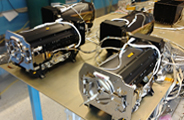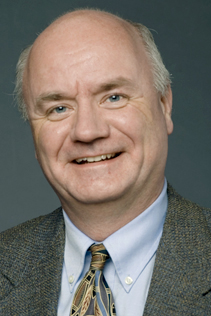Fall 2013
 |
|
| Chris Bancroft |
Senior research project engineer Chris Bancroft was granted a U.S. patent assigned to UNH for a fully resonant power supply design concept. The design is used on a number of past and current projects and proposals within the Space Science Center, including the Gamma Ray Polarimeter Experiment, the Fast Neutron Imaging Telescope, Solar Orbiter and others. The power supply provides a very low noise approach in a very simple and robust design.
 |
|
| Mark McConnell |
Mark McConnell was awarded a NASA Group Achievement Award as a member of the Ramaty High Energy Solar Spectroscopic Imager (RHESSI) Science and Data Analysis Team. Launched in February 2002, RHESSI's primary mission is to explore the basic physics of particle acceleration and explosive energy release in solar flares.
Team members on NASA's Van Allen Probes (Radiation Belt Storm Probes) mission received a Group Achievement Award for Outstanding Performance and Groundbreaking Science from agency headquarters. UNH is the lead institution on the Energetic Particle, Composition, and Thermal Plasma (ECT) instrument suite on board the twin spacecraft. ECT principal investigator Harlan Spence also reports that the stunning scientific achievements have resulted in 30 published papers on ECT results alone since the mission launched in August 2012.
 |
|
| Harald Kucharek |
Just prior to the 5th anniversary of the launch of the Interstellar Boundary Explorer (IBEX) on October 19, 2008, the team—including members from UNH—that built the ultra-high sensitivity IBEX-lo camera reached another milestone. With the help of a retired engineer Eric Hertzberg of Lockheed Martin, a subgroup of the IBEX-lo team successfully assembled a fully functional detector unit out of spare parts of the IBEX-lo sensor. Such an effort had not been planned and was actually considered to be impossible but the team, under the lead of Harald Kucharek, collected enough parts from five different institutions to rebuild a sensor unit. The sensor has been tested and calibrated at the University of Bern and can now be used for post calibration of IBEX-lo flight data and for development activities for the future Interstellar MApping Probe (IMAP) mission. IMAP will expand upon IBEX’s groundbreaking all-sky images of the heliospheric boundaries.
 | |
| Spin-plane Double Probes |
The UNH team that took on the daunting 11th -hour task of constructing multiple flight units for the NASA’s Magnetospheric Multiscale mission reports that all 16 Spin-plane Double Probe (SDP) deployers have successfully completed fabrication and testing and the last set of four will be delivered to the Goddard Space Flight Center in November. In the coming months, the team will assemble and test one additional flight spare unit. Says SDP project manager/systems engineer Brian King, "With completion of this work we've shown for the first time we can build a mechanism—an instrument with moving parts. We usually build ‘passive’ particle instruments so this provides us with an entirely different avenue of potential work." Adds MMS project manager John Macri, “This was an immense challenge and is a remarkable success. I'm very proud of this team.” See the Winter 2011 issue of Spheres for details.
As part of the Yellowstone National Park Ranger summer program, Harlan Spence and Sonya Smith gave multiple space science educational presentations to hundreds of park visitors at the Madison Amphitheater in early August. Spence revealed the latest results from NASA's Van Allen Probes mission in 45-minute talks entitled "Mysteries of the Radiation Belts Revealed," including exciting discoveries from NASA instrumentation that he and Smith lead at UNH. Smith capped each presentation with an active audience participation experience that included a question and answer period, demonstration of a cosmic-ray cloud chamber, and distribution of dozens of do-it-yourself cloud chambers developed by EOS scientist Andrew Jordan.
 |
|
| Noé Lugaz |
Research assistant professor Noé Lugaz received the 2014 Arne Richter Award for Outstanding Young Scientists from the European Geosciences Union. The award recognizes scientific achievements in any field of the geosciences made by a scientist under the age of 35. Four Richter awards were announced this year. Research professor Charlie Farrugia nominated Lugaz for the award and noted that the young scientist has made a number of breakthrough advances on the subject of coronal mass ejections (CMEs) from the sun. Said Farrugia, "Dr. Lugaz has developed sophisticated numerical models to simulate CME expulsion and propagation in the interplanetary medium, and his work bridges the gap between computational and observational solar-terrestrial physics." The award will be presented at the EGU 2014 General Assembly in Vienna in April 2014, where Lugaz will also give a lecture.
Research assistant Robert Allen and research scientist Jichun Zhang published a paper in the Journal of Geophysical Research Space Physics titled "Multiple bidirectional EMIC waves observed by Cluster at middle magnetic latitudes in the dayside magnetosphere." The research was supported by Zhang's NASA Electromagnetic Ion Cyclotron Wave grant and by funds from the Van Allen Probes mission Energetic Particle, Composition, and Thermal Plasma instrument, for which Harlan Spence is principal investigator. Spence and Lynn Kistler are coauthors on the paper.
 | |
| Ian Cohen |
Ph.D. student Ian Cohen published a letter he wrote to NASA administrator Charles F. Bolden, Jr. in AGU's journal Space Weather. The letter, which concerned the current state of heliophysics funding at NASA, was written on behalf of 46 graduate and three undergraduate students from 22 U.S. universities. "The student researchers in the area of Heliophysics and the Sun-Earth connection strongly oppose NASA's proposed budget cuts to the Heliophysics Division, which are in direct opposition to the recommendations of the NRC Decadal Survey," he wrote to Bolden. Within the context of the growing scope of industries susceptible to the effects of the Sun-Earth connection, or space weather, "the significance of high-quality and well-funded research into the dynamics of the Sun-Earth connection cannot be overstated."
 | |
| Fay Rubin |
On September 30, Fay Rubin received the 2013 Peter S. Thacher Award from the Northeast Arc User Group. The annual award recognizes individuals who have demonstrated commitment and excellence in using Geographic Information System (GIS) technology to achieve success in natural resource management and conservation at the local level. Rubin is long-time director of the EOS-based Geographically Referenced Analysis and Information Transfer (NH GRANIT) project, which serves as the statewide geographic information system clearinghouse. Notes Michael Routhier, director of the GIS and Remote Sensing Laboratory at EOS, "Fay has been the guiding force behind NH GRANIT for decades, providing leadership and continuity in GIS data development and distribution. Her work to create and obtain data and find funding on behalf of all users has been the most critical link to the growth and use of GIS in the state and the region."
Jingfeng Xiao co-convened and co-chaired the International Symposium on Global Change Research 2013: Coupled Natural & Human Systems in Nanjing, Jiangsu, China in June. The symposium was held to confront the grand challenges of climate change, ecosystem degradation, loss of biodiversity, and many other environmental issues. It brought scientists and students from many countries together to discuss the topics of human-environment interactions, global change ecology, ecosystem-atmosphere interactions, remote sensing of global change, ecosystem modeling, climatic adaptation, ecosystem services, and climate policy making.
Michael Palace was awarded two new grants. For a NASA project, he and colleagues, including former ESRC scientists Bill Salas, Steve Hagen (principal investigator), and Rob Braswell, will develop a national level estimate of forest biomass, as well as deforestation and degradation estimates for Kalimantan, Indonesia. The work involves remote sensing using optical and lidar sensors on both airborne and spaceborne platforms. For an NSF-funded project, principal investigator Adrienne Kovach of the UNH department of natural resources and the environment and Palace will integrate Earth observations with ecological and land use models to examine the potential for restoring connectivity in a vulnerable ecosystem—the early successional forest in the northeastern U.S., which is critical habitat for the endangered New England cottontail.
 |
||
| Sarah Schulenberg | ||
Jack Dibb, Eric Scheuer, and Sarah Schulenberg took part in NASA's Studies of Emissions and Atmospheric Composition, Clouds and Climate Coupling by Regional Surveys (SEAC4RS) field campaign from August through September. The study, based out of Houston, TX, used research aircraft to investigate how the combination of summer storms and rising air pollution from wildfires, cities, and other sources can change climate. Research technician Schulenberg also spent time this summer in the Gulf of Mexico on a cruise related to DISCOVER-AQ—a NASA airborne campaign also based out of Houston and aimed at learning how to improve air quality retrievals from satellite. OPAL's Joe Salisbury and Sean Shellito also participated in the cruise.
 | |
| Ruth Varner |
Ruth Varner has been appointed director of the Joan and James Leitzel Center for Mathematics, Science and Engineering Education. She has also recently brought two postdoctoral researchers to her laboratory, Carmody "Carrie" McCalley (Ph.D. Cornell University) and Duc Nguyen (Ph.D. Stockholm University) whose research will focus on trace gas emissions from temperate and permafrost peatlands and lakes.
Alexandra Contosta has been promoted to research scientist II in the ESRC.
Postdoc Matt Vadeboncoeur published a paper in Environmental Science & Technology titled "From Missing Source to Missing Sink: Long-term Changes in the Nitrogen Budget in a Northern Hardwood Forest." The paper concerns biogeochemical monitoring over 45 years at the Hubbard Brook Experimental Forest in New Hampshire that has revealed multiple surprises, seeming contradictions, and unresolved questions in the long-term record of ecosystem nitrogen dynamics. The bottom line, notes Vadeboncoeur, is that the nitrogen cycle at Hubbard Brook is currently out of balance, "but we can't tell exactly how. Some of the nitrogen pollution deposited to the forest is either being stored in the soil or lost via denitrification—probably some of both. And the balance between these processes really matters; storing soil nitrogen results in sequestering extra carbon, while denitrification releases nitrous oxide, a potent greenhouse gas."
 |
|
| Claire Treat | |
 |
|
| Steve Frolking |
Claire Treat and Steve Frolking published a News and Views piece in the October 2013 issue of Nature Climate Change on the fate of carbon stored in Arctic permafrost under changing climate conditions. Field and laboratory studies from Greenland show that the fate of permafrost soil carbon following thaw is highly dependent on local hydrology. Specifically, when soils remain very wet, as is common near the surface of permafrost, carbon loss is low. However, when soils were drained in laboratory experiments, carbon losses approached 10 to 20 percent per year. Treat is studying interactions between hydrology and temperature in lab experiments in Alaskan peatlands for her dissertation research. Small carbon losses occur at cool temperatures under both drier and flooded conditions, but carbon losses are twice as large in warmer, drier soils than warmer, flooded soils. These results highlight one of the key uncertainties in the response of soil organic carbon to permafrost thaw: will ecosystems become drier or wetter—a carbon bomb or slow fizz? Treat is a U.S. Department of Energy Office of Science Graduate Fellow and a candidate in the Natural Resources and Earth Science Systems Ph.D. program.
 | |
| Doug Vandemark |
Doug Vandemark attended an international conference in France on atmosphere-ocean carbon dioxide exchange, presenting research showing that satellite observations can help monitor the rate of carbon dioxide uptake by the global ocean. OPAL scientists Vandemark, Tim Moore and Joe Salisbury conducted the research in support of European Space Agency efforts to further exploit Earth-observing satellites.
Vandemark and Hui Feng attended NASA's Ocean Surface Topography Science Team Meeting, held in Boulder, CO October 7-11. They presented a new study detailing ocean currents in the Gulf of Maine region as measured using satellite altimetry.
 | |
| Chris Glass |
In July, Chris Glass traveled to Chile to teach a graduate course jointly offered by Pontificia Universidad Católica de Valparaiso and Universidad Católica de la Santísima Concepción. The course, "Bycatch Reduction and Mitigation Measures for Global Fisheries," was attended by several officials from the Chilean Ministry of Fisheries who invited Glass back to attend two large fisheries meetings in October, including a daylong workshop at ministry headquarters in Valparaiso. The workshop included representatives from all branches of government with responsibility for managing and overseeing fisheries in Chile and international waters. The Chilean hake fishery was once the economic engine of the southern oceans and a mainstay of the Chilean economy but the stock is currently in crisis and near collapse with catches down by two-thirds. Chilean hake accounts for over 70 percent of fresh hake consumption globally. Chile recently enacted a new suite of fisheries management laws and is struggling with how to make management effective. Glass, whose work directing the Northeast Consortium has positioned him as a world leader in finding collective (between the fishing industry, government, and scientists) solutions to fisheries problems, was invited to help push things forward in a collaborative fashion.
 |
||
| Emily Klein | ||
Emily Klein successfully defended her Ph.D. at the end of October. A student of former EOS faculty member Andy Rosenberg, Klein's research was the first to explore nonlinearity in an ecologically and economically vibrant, less degraded ecosystem of the past. Investigations combined novel analytical approaches and historical data (circa 1870-1920) to expand knowledge on ecosystem dynamics, spatial structure, and resilience for the Bay of Fundy.

